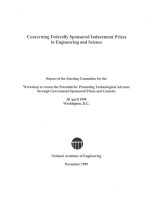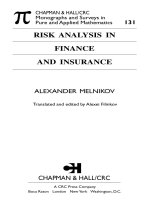Secure Coding in C and C++ pdf
Bạn đang xem bản rút gọn của tài liệu. Xem và tải ngay bản đầy đủ của tài liệu tại đây (842.14 KB, 135 trang )
© 2010 Carnegie Mellon University
Secure Coding in C and C++
This material is approved for public release.
Distribution is limited by the Software Engineering Institute to attendees.
Module 4, Dynamic Memory Management
2
© 2010 Carnegie Mellon University
This material is distributed by the SEI only to course attendees for their own individual study.
Except for the U.S. government purposes described below, this material SHALL NOT be
reproduced or used in any other manner without requesting formal permission from the Software
Engineering Institute at
.
This material was created in the performance of Federal Government Contract Number FA8721-
05-C-0003 with Carnegie Mellon University for the operation of the Software Engineering Institute,
a federally funded research and development center. The U.S. Government's rights to use, modify,
reproduce, release, perform, display, or disclose this material are restricted by the Rights in
Technical Data-Noncommercial Items clauses (DFAR 252-227.7013 and DFAR 252-227.7013
Alternate I) contained in the above identified contract. Any reproduction of this material or portions
thereof marked with this legend must also reproduce the disclaimers contained on this slide.
Although the rights granted by contract do not require course attendance to use this material for
U.S. Government purposes, the SEI recommends attendance to ensure proper understanding.
THE MATERIAL IS PROVIDED ON AN “AS IS” BASIS, AND CARNEGIE MELLON DISCLAIMS
ANY AND ALL WARRANTIES, IMPLIED OR OTHERWISE (INCLUDING, BUT NOT LIMITED TO,
WARRANTY OF FITNESS FOR A PARTICULAR PURPOSE, RESULTS OBTAINED FROM USE
OF THE MATERIAL, MERCHANTABILITY, AND/OR NON-INFRINGEMENT).
3
Agenda
Dynamic Memory Management
Common Dynamic Memory Management Errors
Doug Lea’s Memory Allocator
Buffer Overflows
Double-Free
Mitigation Strategies
Summary
4
Dynamic Memory Management
Memory allocation in C
▪ calloc()
▪ malloc()
▪ realloc()
Deallocated using the free() function
Memory allocation in C++ uses the new operator
Deallocated using the delete operator
May also use C memory allocation
5
Memory Management Functions 1
malloc(size_t size);
▪ Allocates size bytes and returns a pointer to the
allocated memory.
▪ The memory is not cleared.
free(void * p);
▪ Frees the memory space referenced by p, which must
have been returned by a previous call to malloc(),
calloc(), or realloc().
▪ If free(p) has already been called before, undefined
behavior occurs.
▪ If p is NULL, no operation is performed.
6
Memory Management Functions 2
realloc(void *p, size_t size);
▪ Changes the size of the memory block pointed to by p to
size bytes.
▪ The contents are unchanged to the minimum of the old
and new sizes.
▪ Newly allocated memory is uninitialized.
▪ If p is NULL, the call is equivalent to malloc(size).
▪ If size is equal to zero, the call is equivalent to
free(p).
▪ Unless p is NULL, it must have been returned by an
earlier call to malloc(), calloc(), or realloc().
7
Memory Management Functions 3
calloc(size_t nmemb, size_t size);
▪ Allocates memory for an array of nmemb elements of
size bytes each and returns a pointer to the allocated
memory.
▪ The memory is set to zero.
8
Memory Managers
Manage both allocated and deallocated memory.
Run as part of the client process.
Use a variant of the dynamic storage allocation
algorithm described by Knuth in The Art of Computer
Programming.
Memory allocated for the client process and memory
allocated for internal use is all within the addressable
memory space of the client process.
[Knuth 97] D. E. Knuth. Fundamental Algorithms, volume 1 of The Art
of Computer Programming, chapter 2, pages 438–442. Addison-
Wesley, 3rd edition, 1997. (First copyrighted 1973, 1968)
9
Boundary Tags
Chunks of memory contain size information fields
both before and after the chunk, allowing
▪ two bordering unused chunks to be coalesced into one
larger chunk (minimizing fragmentation)
▪ all chunks to be traversed from any known chunk in either
direction [Knuth 97]
10
Dynamic Storage Allocation 1
Best-fit method - An area with m bytes is selected,
where m is the smallest available chunk of
contiguous memory equal to or larger than n.
First-fit method - Returns the first chunk encountered
containing n or more bytes.
To prevent fragmentation, a memory manager may
allocate chunks that are larger than the requested
size if the space remaining is too small to be useful.
11
Dynamic Storage Allocation 2
Memory managers return chunks to the available
space list as soon as they become free and
consolidate adjacent areas.
The boundary tags are used to consolidate adjoining
chunks of free memory so that fragmentation is
avoided.
12
Agenda
Dynamic Memory Management
Common Dynamic Memory Management Errors
Doug Lea’s Memory Allocator
Buffer Overflows (Redux)
Double-Free
Mitigation Strategies
Summary
13
Memory Management Errors
Initialization errors
Failing to check return values
Writing to already freed memory
Freeing the same memory multiple times
Improperly paired memory management functions
Failure to distinguish scalars and arrays
Improper use of allocation functions
14
Initialization Errors
Most C programs use malloc() to allocate blocks of
memory.
A common error is assuming that malloc() zeros
memory.
Initializing large blocks of memory can impact
performance and is not always necessary.
Programmers have to initialize memory using
memset() or by calling calloc(), which zeros the
memory.
15
Initialization Error
/* return y = Ax */
int *matvec(int **A, int *x, int n) {
int *y = malloc(n * sizeof(int));
int i, j;
for (i = 0; i < n; i++)
for (j = 0; j < n; j++)
y[i] += A[i][j] * x[j];
return y;
}
Incorrectly assumes y[i] is
initialized to zero
16
“Sun tarball” Vulnerability
tar is used to create archival files on UNIX systems.
The tar program on Solaris 2.0 systems inexplicably
included fragments of the /etc/passwd file (an example of
an information leak that could impact system security).
▪ The tar utility failed to initialize the dynamically allocated
memory used to read data from the disk.
▪ Before allocating this block, the tar utility invoked a
system call to look up user information from the
/etc/passwd file.
▪ The memory chunk was then recycled and returned to
the tar utility as the read buffer.
Sun fixed this problem by replacing the call to malloc()
with a call to calloc() in the tar utility.
17
Failing to Check Return Values
Memory is a limited resource and can be exhausted.
Memory allocation functions report status back to the
caller.
▪ malloc() function returns a null pointer
▪ VirtualAlloc() also returns NULL
▪ Microsoft Foundation Class Library (MFC) operator new
throws CMemoryException *
▪ HeapAlloc() may return NULL or raise a structured
exception
The application programmer needs to
▪ determine when an error has occurred
▪ handle the error in an appropriate manner
18
Checking malloc() Status
int *i_ptr;
i_ptr = malloc(sizeof(int)*nelem);
if (i_ptr != NULL) {
i_ptr[i] = i;
}
else {
/* Recover from error */
}
Take care the
multiplication
does not result
in an integer
overflow
19
Recovery Plan
When memory cannot be allocated, a consistent
recovery plan is required.
PhkMalloc provides an X option that instructs the
memory allocator to abort() the program with a
diagnostic message on standard error rather than
return failure.
This option can be set at compile time by including in
the source:
extern char *malloc_options;
malloc_options = "X";
20
C++ Allocation Failure Recovery
The standard behavior of the new operator in C++ is
to throw a bad_alloc exception in the event of
allocation failure.
T* p1 = new T; // throws bad_alloc.
T* p2 = new(nothrow) T; // returns 0
Using the standard form of the new operator allows a
programmer to encapsulate error-handling code for
allocation.
The result is cleaner, clearer, and generally more
efficient design.
21
new operator Exception Handling
try {
int *ip = new int;
. . .
}
catch (bad_alloc) {
// handle failure from new
}
22
Incorrect use of new Operator
int *ip = new int;
if (ip) { // always true
}
else {
// never executes
}
If code execution gets there it means
that that allocation succeeded.
If no such handler exists, control is transferred from the current
scope to a higher block in the calling chain. This process continues
until an appropriate handler has been found. In the absence of an
appropriate handler, the program terminates.
When an exception is thrown,
the runtime mechanism first
searches for an appropriate
handler in the current scope.
23
C++ and new_handlers
C++ allows a callback, a new handler, to be set with
std::set_new_handler.
The callback must
▪ free up some memory,
▪ abort,
▪ exit, or
▪ throw an exception of type std::bad_alloc.
The new handler must be of the standard type
new_handler:
typedef void (*new_handler)();
24
new_handlers in C++
operator new will call the new handler if it is
unable to allocate memory.
If the new handler returns, operator new will re-
attempt the allocation.
extern void myNewHandler();
void someFunc() {
new_handler oldHandler
= set_new_handler( myNewHandler );
// allocate some memory…
// restore previous new handler
set_new_handler( oldHandler );
}
25
Referencing Freed Memory 1
Once memory has been freed, it is still possible to read or
write from its location if the memory pointer has not been
set to null.
An example of this programming error:
for (p = head; p != NULL; p = p->next)
free(p);
The correct way to perform this operation is to save the
required pointer before freeing:
for (p = head; p != NULL; p = q) {
q = p->next;
free(p);
}









